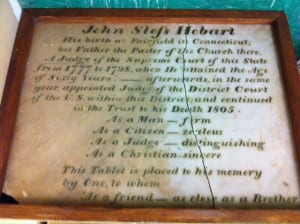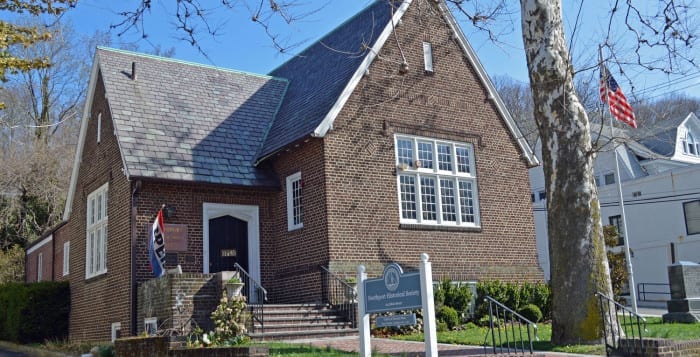By Eric Santiago
Over the last year, a group of Northport-East Northport teachers and students have worked to preserve an overlooked piece of Long Island’s history.
Eaton’s Neck was home to a leading patriot, forgotten except by a few local history buffs. Yet the biography of John Sloss Hobart (1738-1805) reads like the résumé of a Revolutionary War hero. Born in Connecticut, Hobart went on to graduate from Yale University, join the American resistance, help draft the New York State Constitution, briefly becoming a U.S. senator and eventually accepting a federal judgeship.
Unlike Revolutionary War-era icons like Nathan Hale or Paul Revere, Hobart’s name largely faded into obscurity.
“For some reason his name didn’t stand out the way theirs did,” Peter White, a retired social studies teacher who taught at Northport Middle School, said.
But there are pieces of Hobart’s legacy that survive. After his death in 1805, a close friend of Hobart’s, the judge Egbert Benson, commissioned a marble tablet in Hobart’s honor.
Bearing an inscription that praised his work in life, the Hobart tablet spent about the next 150 years in the basement of New York City Hall, according to a letter White co-wrote to the Northport-East Northport school board. This was until Richard Streb, a teacher at Northport High School, discovered the tablet in 1963. He convinced then-Mayor Robert Wagner’s administration to sell the tablet to the Northport-East Northport school district for $1.

It’s bounced around Northport-East Northport schools ever since, most recently embedded in the wall of the auditorium at Northport Middle School. When Streb retired in 1981, he asked White, his close friend and protégé, to look after the tablet.
It gathered dust in the back of the auditorium until last December when music department chairperson, Izzet Mergen, considered dedicating the space to former music department chairperson, Robert Krueger.
Realizing that moving the tablet would be a sensitive issue, Mergen contacted White, who then contacted Kathleen Cusumano, a permanent substitute teacher at Northport Middle School. A former student of White’s and a local history expert, Cusumano and the others formed a group to decide the tablet’s fate. The goal was to find somewhere the tablet could be seen and appreciated.
“We had the task of trying to figure out what to do with it,” White said.
Sensing this could be a valuable learning experience, Cusumano started recruiting students to help with the search.
“We have middle school students who are living on Hobart land,” Cusumano said. “There’s always that connection when you’re trying to teach history — that tangible connection of actually seeing something that really existed and didn’t just come out of a textbook.”
Now with a dozen students in tow, the group began exploring possible homes for the tablet. Several places were considered, with the Northport Historical Society, Northport Library and Huntington Town Hall as some of the most popular contenders. The students visited these locations before voting on where they would recommend the tablet be placed. Ultimately the school district, which owns the tablet, had the final say.
Heather Johnson, the director of the historical society, remembers when the students visited. She was particularly impressed with their thoughtful questions.
“For somebody who works in a historical society, we’re always trying get people involved of all ages interested in history,” she said. “There’s nothing more heartwarming and positive to see — really any group — but certainly a young group who are trying to make a difference.”
After the visit, the students started to lean toward the historical society, but they were reluctant to declare a permanent home for the tablet, Cusumano said. What if no one came to the historical society? Could they guarantee that some place like the library wouldn’t guarantee more visibility?
But the students managed to come up with a compromise, according to Cusumano; they decided to ask that the tablet only be loaned for a year. If the historical society turned out to be a poor fit, the tablet could be moved elsewhere at the end of the year.
The school board approved this recommendation at a recent meeting. According to district clerk, Beth Nystrom, the tablet will be moved to the historical society once the attorneys from both parties draft the formal agreement to loan the tablet.
For their part, Johnson said the historical society was proud and excited to add the tablet to their collection.
“When we found out we were the top choice, we were delighted and honored,” she said. “[The students] did their research, and that made it even more meaningful to be chosen.”
Cusumano also praised the students’ dedication. She stressed that some of the best learning can only be done outside of the classroom.
“I think when you experience — when you have experiential learning — it stays with you,” she said. “More things like field trips where [the students] can get involved, I believe, makes for a lifelong learner.”





